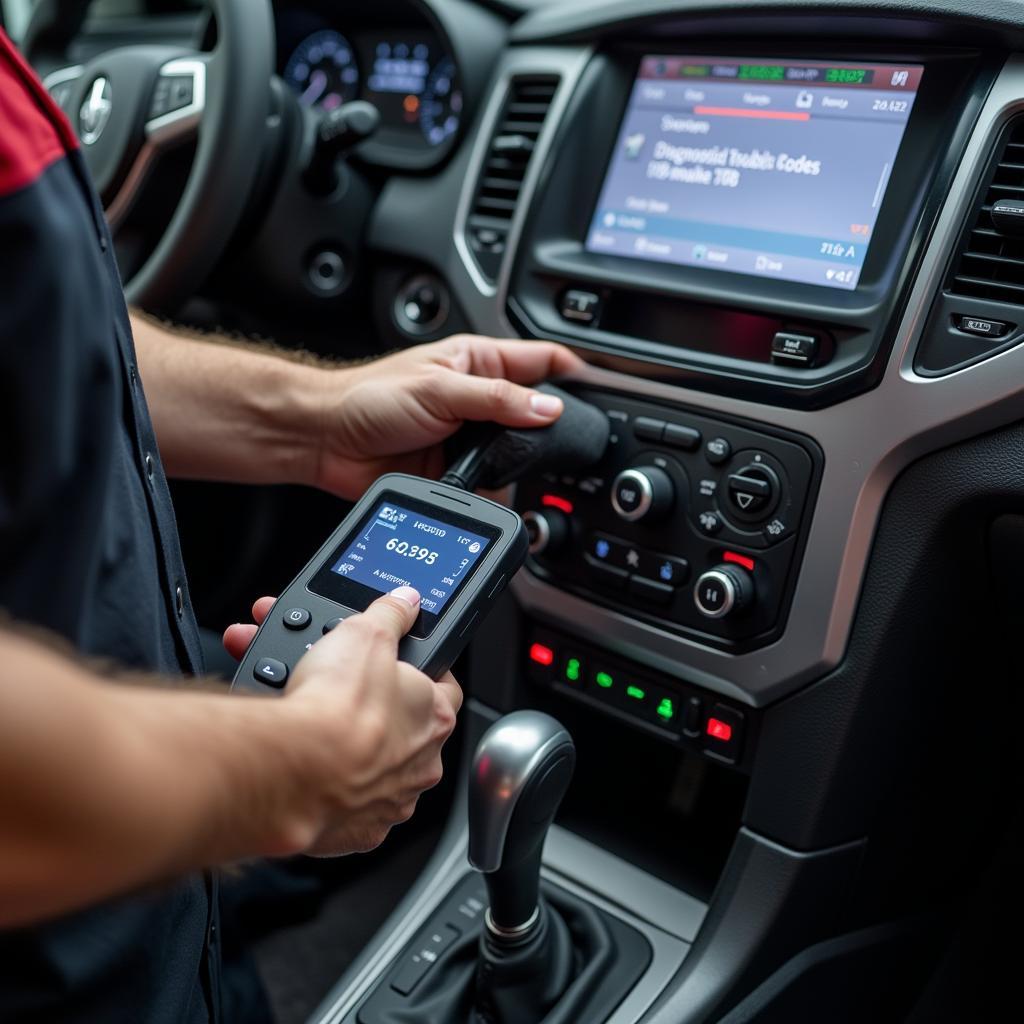Have you ever seen a warning light pop up on your dashboard and wondered what it meant? That, my friend, is your car trying to communicate with you using diagnostic trouble codes (DTCs). This article will delve into the world of car diagnostic codes, explaining what they are, how they work, and what you need to know.
What is a Car Diagnostic Code?
A car diagnostic code is a five-character alphanumeric code that indicates a specific problem area within your vehicle’s systems. Think of it like your car’s version of Morse code, transmitting vital information about its health. These codes are generated by your vehicle’s onboard computer, also known as the Engine Control Unit (ECU), when it detects a malfunction in the engine, transmission, emissions system, or other critical components.
How are Car Diagnostic Codes Structured?
Each diagnostic code follows a standardized format:
- The first character: This is a letter indicating the system where the fault lies.
- P: Powertrain (engine, transmission, and associated systems)
- B: Body (airbags, power windows, central locking)
- C: Chassis (ABS, traction control, steering)
- U: Network communication (between different control modules)
- The second character: This is a number. “0” typically indicates a standardized code used across different car manufacturers, while “1” often signifies a manufacturer-specific code.
- The third character: This pinpoints the specific subsystem related to the fault (e.g., fuel, air, ignition).
- The final two characters: These provide a more detailed description of the specific problem within the subsystem.
 Car Diagnostic Code Structure
Car Diagnostic Code Structure
How Do Diagnostic Codes Help Mechanics?
Imagine trying to fix a complex machine with no idea where to start. That’s the situation a mechanic faces without diagnostic codes. These codes act like a roadmap, guiding mechanics directly to the source of the issue. By plugging a specialized tool called an OBD-II scanner into your vehicle’s diagnostic port, mechanics can read these codes and:
- Identify the problem area quickly: Instead of spending hours examining every system, mechanics can focus on the specific area indicated by the code, saving time and effort.
- Access detailed information: Many OBD-II scanners provide additional data associated with the code, such as freeze frame data (a snapshot of the engine conditions when the code was triggered), which can be invaluable in diagnosing intermittent issues.
- Perform targeted repairs: Knowing the exact problem allows for precise repairs, preventing unnecessary part replacements and reducing overall repair costs.
 Mechanic Using OBD Scanner to Diagnose Car Problem
Mechanic Using OBD Scanner to Diagnose Car Problem
Can I Diagnose and Fix Car Problems Myself?
While it’s tempting to tackle car repairs yourself, especially with the wealth of information available online, proceeding with caution is crucial. Here’s why:
- Misinterpretation of codes: While some codes seem self-explanatory, they often require a deeper understanding of the vehicle’s systems and their interconnectivity. Misinterpreting a code can lead to unnecessary repairs or even exacerbate the problem.
- Complexity of modern vehicles: Today’s cars are incredibly complex, with intricate electronic systems and software. Attempting repairs without the proper knowledge and tools can have unintended consequences, potentially causing further damage.
Remote car diagnostics is a great option if you’re unsure how to fix the problem yourself.
Understanding Common Diagnostic Trouble Codes
While thousands of DTCs exist, some appear more frequently than others. Here are a few examples:
- P0420 (Catalyst System Efficiency Below Threshold): This often indicates a problem with the catalytic converter, a vital component in reducing harmful emissions.
- P0300 (Random/Multiple Cylinder Misfire Detected): This points to an engine misfire, which can be caused by various factors like faulty spark plugs, ignition coils, or fuel injectors.
- P0171 (System Too Lean (Bank 1)): This code suggests there’s too much air or not enough fuel in the air-fuel mixture entering the engine, often due to a vacuum leak or a problem with the oxygen sensor.
Diagnostic test car p0093 can help you understand and address this specific code.
What to Do When Your Check Engine Light Turns On
Seeing that dreaded check engine light illuminate on your dashboard can be unsettling, but don’t panic. Here are the steps you should take:
- Don’t ignore it: While a check engine light doesn’t always signal a critical issue, ignoring it can lead to more severe problems and costlier repairs down the line.
- Check your gas cap: A loose or faulty gas cap is a surprisingly common culprit behind check engine lights. Make sure it’s securely tightened.
- Use an OBD-II scanner (or visit a mechanic): If the check engine light persists, retrieve the diagnostic code using an OBD-II scanner. If you’re not comfortable doing this yourself, take your car to a trusted mechanic or dealership.
Mobile car diagnostic iow offers a convenient solution by bringing the diagnostics directly to you.
Car Diagnostic Codes: Your Key to Effective Car Care
Understanding car diagnostic codes empowers you to take proactive measures in maintaining your vehicle. While professional diagnostics are essential for accurate diagnosis and repair, having a basic grasp of DTCs allows you to:
- Communicate effectively with mechanics: Knowing the code beforehand helps streamline the diagnostic process and ensures you understand the issue at hand.
- Make informed decisions: Understanding the severity of the problem allows you to make informed decisions about repair urgency and budget allocation.
- Prevent future issues: Regularly checking and addressing diagnostic codes can help identify minor problems before they escalate into major headaches, saving you time, money, and potential roadside troubles.
In conclusion, think of car diagnostic codes as your vehicle’s way of speaking to you. By learning its language, you can become a more informed and proactive car owner, ensuring your vehicle stays healthy and on the road for miles to come. Need assistance with car diagnostics or repairs? Contact us via WhatsApp: +1(641)206-8880 or Email: [email protected]. Our dedicated team is available 24/7 to provide expert support and guidance.

Leave a Reply